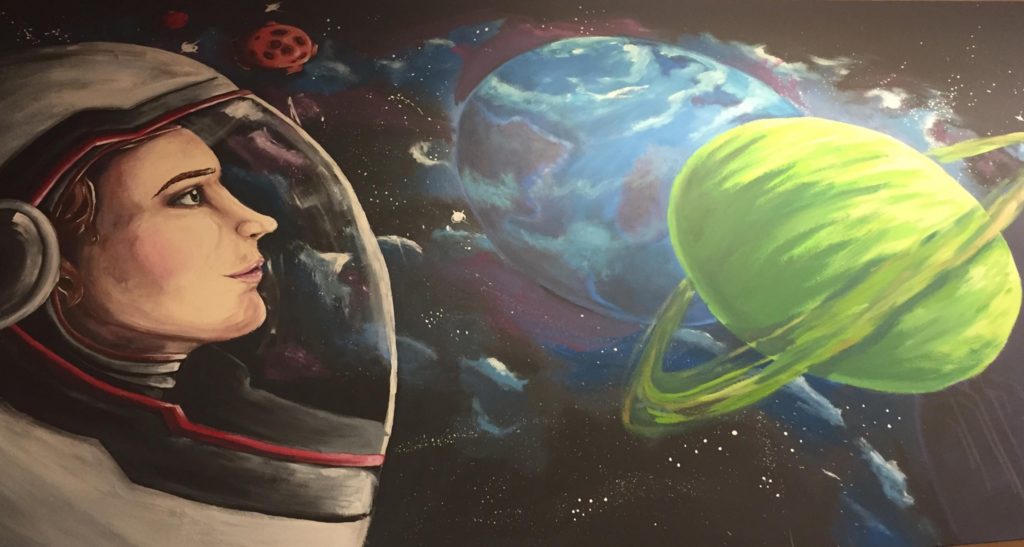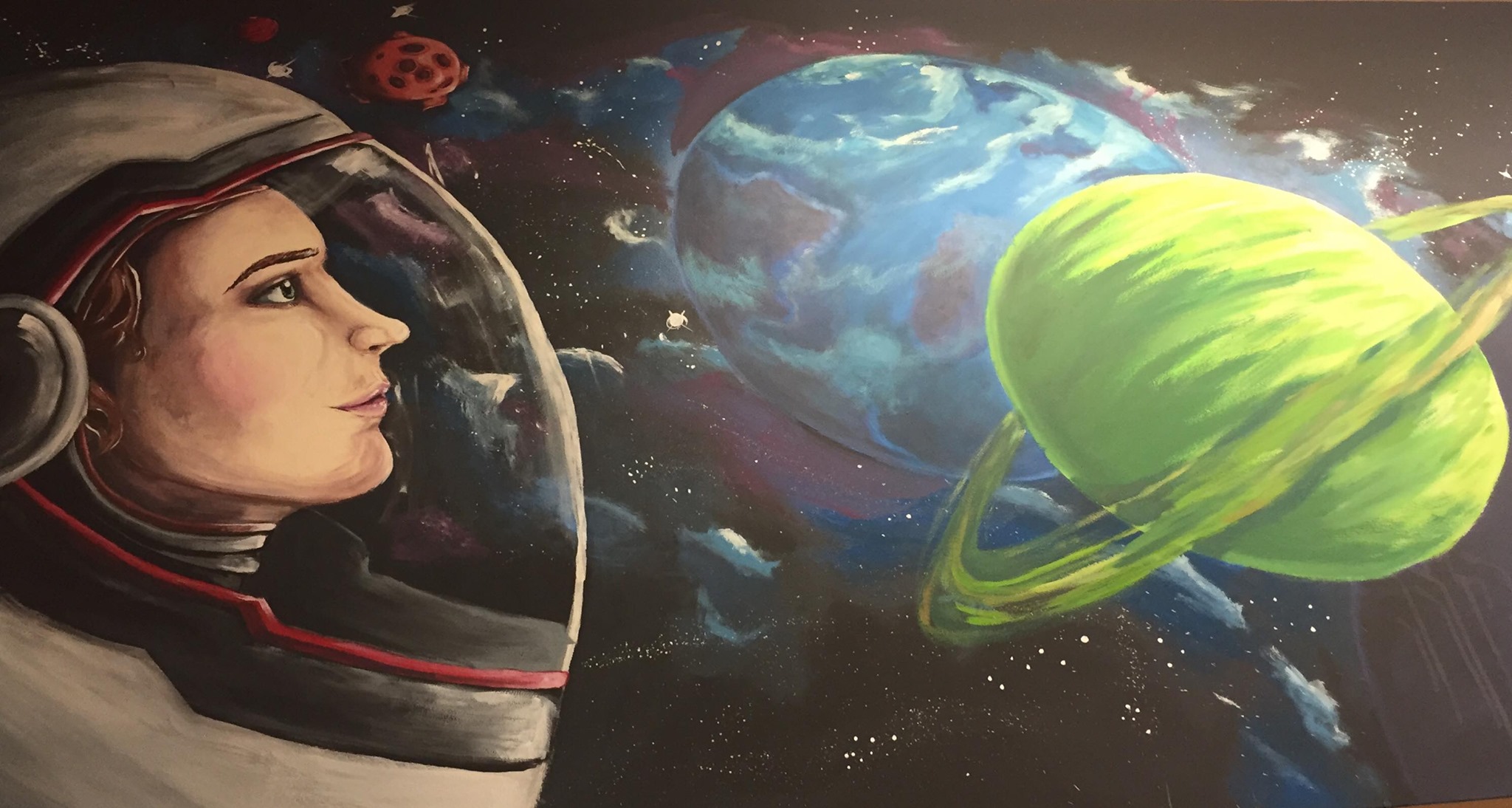The Green Bank Observatory and Science Center has a new feature — a 64-foot-long-by-5-foot-tall mural in the Exhibit Hall.

Artwork and photos courtesy of Rebekah Anderson.
A female astronaut gazes into the vast expanses of the cosmos, captured by the artist as hypnotic swirls dotted with hundreds of bright stars surrounding her.
Luminescent planets float through rich, purple and blue galaxies. A spacecraft seems to blast right off the wall, its destination the far reaches of the universe, the edges of infinity.

The hand-painted masterpiece was created by Green Bank Science Center’s own Rebekah Anderson, a tour guide with out-of-this-world artistic talent. Originally hailing from Tennessee, the 23-year-old artist has lived in Green Bank since she was 6.
In the sixth grade, Anderson started carrying around a sketchbook. She started with doodles and some pencil drawings. She kept drawing, getting better and better through the years, evolving from penciled doodles in margins to watercolor paintings large enough to be seen from space.
In high school, her art teacher saw in Anderson a raw talent that could be cultivated into more and encouraged her to pursue painting as more than just a hobby. Anderson began to contemplate a future in art, but it wasn’t until she was accepted into the 2012 Governor’s School for the Arts that she felt confident she could make a career built on watercolor paints and penciled sketches.
The Governor’s School for the Arts is a three-week summer program for rising high school juniors interested in the arts. The program accepts 100 students from across the state to study art, digital art, theater, instrumental music, vocal music or creative writing.
In 2016, Anderson was back in Green Bank after finishing her sophomore year at Carson-Newman University in Tennessee, where she was studying for her B.A. in art. That’s when she became involved with the Green Bank Observatory and Science Center.
She started as a part-time tour guide and became full time after she graduated college. Since she started work at the science center, Anderson’s art has narrowed to a specific subject: outer space.
“The possibilities are endless,” Anderson is quick to point out.
Though originally intended for a smaller wall on the ground level, Anderson rose to the challenge of a galactic-sized mural fit to represent the known universe and hopefully encourage the next generation to explore farther beyond.
“Exploration and imagination were my inspiration for this mural. We have explored our local cosmic neighborhood and have discovered a lot of objects in our universe. However, in the grand scheme of the universe, we have barely scratched the surface,” Anderson said. “With this mural, maybe someone will look at it and actually go try to find a green planet.”

Anderson started small — ish
According to Anderson, she began with concept drawings and rough sketches. Then moved onto the scale drawing, which ended up 10.5 feet long by 6 feet tall. After five months of planning, she was ready to begin the final product.
Standing on scaffolding as the center’s daily activities unfolded below her, Anderson took her trusty pencil and starting sketching her design. For the planets, she used a thumbtack, string and pencil as a makeshift compass, but the rest she drew freehand.
For three months, Anderson slaved in the stratosphere of the Exhibit Hall, using her watercolor paints to bring the cosmos to life.
On the left, a female astronaut looks out across the expanse of the known galaxy. Earth stands visible in the background, tucked just behind a Saturn-esque celestial body.

“The female astronaut was created to celebrate women who have traveled to space, and women in STEM and astronomy,” Anderson said.
She said the astronaut is modeled after Sally Ride, the first American female in space. But, according to Anderson, “Several of my co-workers and friends think she looks like them.”
Moving to the right, another astronaut reaches for an orange planet, small enough to fit in the spaceman’s gloved hand.

“The second astronaut was created with the idea of exploration,” Anderson said. “It seems odd that an astronaut is reaching out for a planet the size of a basketball, but it represents our next mission: Mars. With the astronaut reaching out for a Mars-like planet, it represents us as humans reaching for our next goal in space travel.”
Beyond that, blues, blacks, purples and brilliant whites swirl into a miniature galaxy, complete with what appears to be a sun at its center. And then there are the magenta clouds of stardust, where a spacecraft prepares to soar into the unknown.

“With collaboration from the Education & Public Outreach team, it was decided that there should be a spacecraft coming out of the solar system,” Anderson said. “Voyager I was chosen because it is the spacecraft farthest from Earth. There are still many parts of the solar system we have not explored.”
According to Anderson, replicating Voyager I was the hardest part of the painting. (Not counting spending hours on a shaky scaffold. Or trying to figure out how to fill 320 square feet of blank canvas.)

“Geometric shapes tend to be a bit more challenging to paint and shade than organic shapes,” Anderson said.
And at the far end of the mural, deep purples roil and build like a celestial thunderstorm. According to Anderson, the far right of the mural represents the planets and exoplanets discovered in the last 25 years.
As intimidated as Anderson was by the challenge of filling such an enormous space, she successfully packed every inch with color and wonder.
“Now that it is complete,” Anderson said, “I am happy to say I couldn’t be prouder.”




